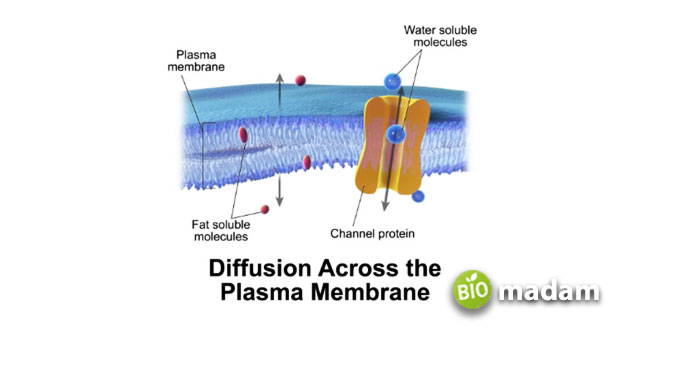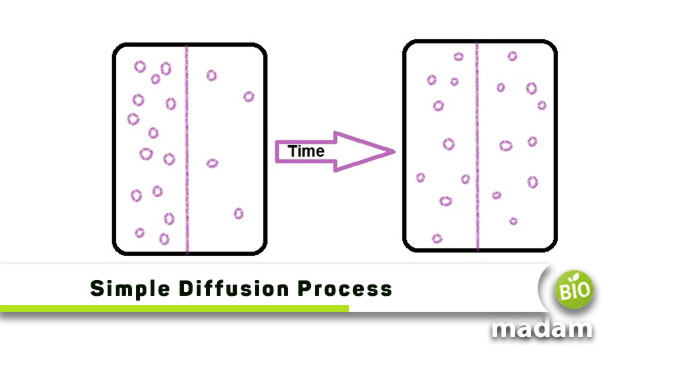Cells are made of several organelles, which are responsible for sustaining life. One of the main components of an animal cell is the cell membrane. The cell membranes of cells are selectively permeable. It regulates the entry and exit of substances into and out of the cell. Useful substances are entered into the cell whereas waste materials are excreted out of the cell. This exchange of materials is called membrane transport. It is responsible for maintaining homeostasis.
There are different types of membrane transport. The two main types of membrane transport are passive transport and active transport. Passive transport allows the movement of molecules along the concentration gradient and it does not require any energy. There are two types of passive transport, osmosis and diffusion. If you are wondering, ”Does simple diffusion require energy?” then let’s find out all about diffusion, its mechanism, its types, and whether it requires energy or not.
What is Simple Diffusion?
Simple diffusion is a type of passive transport. It involves the movement of molecules along the concentration gradient. Molecules tend to move from an area of high concentration to an area of low concentration. This movement continues until the concentration becomes equal.
Mechanism of Simple Diffusion
The mechanism of simple diffusion can be explained by an example. If a person opens a bottle of perfume in a room, then the concentration of the perfume is highest in the bottle and lowest in the corner of the room. The molecules or vapors of perfumes will slowly start to diffuse with the molecules of air present in the room and the scent of the perfume will be spread throughout the room. Thus, the movement or spread of molecules occurred from an area of high concentration to an area of low concentration.
Example of Simple Diffusion
Different materials move across the plasma membrane by diffusion and certain materials move within the cytosol of the cell by diffusion. Another common example of simple diffusion is the exchange or transport of gases during breathing. The concentration of oxygen in the air is 20%, and in our blood, it is 15%. So, the partial pressure of oxygen is higher in the air as compared to our bloodstream. As a result, diffusion causes oxygen to enter the bloodstream.

Does Simple Diffusion Require Energy?
No, simple diffusion does not require energy as the molecules move along the concentration gradient and this does not require energy. Molecules easily flow from high concentration to low concentration without the expending of energy. However, facilitated diffusion is another type of diffusion that requires energy in the form of membrane proteins. These membrane proteins allow the movement of molecules against the concentration gradient.
Difference between Simple Diffusion and Facilitated Diffusion
The differences between simple and facilitated diffusion are mentioned in the table below:
| Simple Diffusion | Facilitated Diffusion |
| Requires no energy | Requires energy in the form of membrane proteins |
| Movement occurs down the concentration gradient. | Movement occurs against the concentration gradient. |
| Movement of hydrophobic and small uncharged molecules | The movement of charged and large polar molecules |
Factors Affecting the Rate of Diffusion
The rate of simple diffusion depends upon the following factors:
Extent of Concentration Gradient
The rate of diffusion will be high when the extent of the concentration gradient is greater. As the concentration gradient becomes close to equilibrium, the rate of diffusion slows down.
Mass of Molecules
Molecules having greater mass will move slowly as they are heavier and it is difficult for them to move as compared to molecules having smaller mass.
Temperature
When the temperature is increased, the energy increases, and the movement of molecules also increases thus, the rate of diffusion increases.
Solvent Density
Solvent density affects inversely the rate of diffusion as the molecules face difficulty moving through a denser medium.
Bottom Line
Membrane transport is an important process occurring in cells. It allows the movement of molecules into and out of the cells. Useful substances are entered into the cells and harmful wastes are transported out of the cells. Simple diffusion is a form of passive transport that allows the movement of molecules along the concentration gradient until equilibrium is reached. This form of transport does not require any energy. Molecules move from an area of high to low concentration, and no energy is used in this process. The rate of simple diffusion is affected by the extent of concentration gradient, temperature, mass of molecules, and solvent density.
FAQs
Why simple diffusion does not require energy?
Simple diffusion does not require energy as the molecules flow down their concentration gradient. Such a type of movement does not require any energy. Small and uncharged molecules can freely move across the membrane without needing any energy.
How is simple diffusion different from osmosis?
Simple diffusion refers to the molecules moving from an area of high concentration to an area of low concentration whereas osmosis specifically refers to the movement of water molecules from high concentration to low concentration.
What are the three rules for simple diffusion?
The three rules of diffusion are:
- Molecules move from an area of high concentration to a low concentration
- Molecules or substances continue to move until an equilibrium is established across the membrane
- It is a passive form of transport and does not require energy to occur

Anna has completed her degree in Pharmacy from the University of Hawaii. She is serving as a research assistant in a pharmaceutical company. She had a great interest in writing blogs, traveling to different parts of the US, and trying delicious recipes in her spare time.

